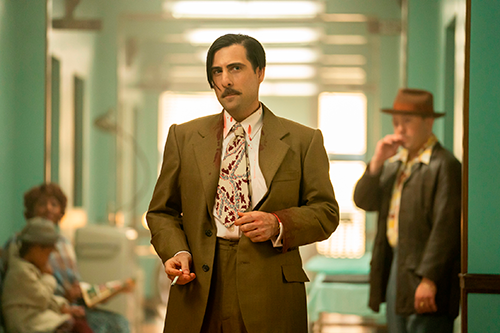Central Library will close early Thursday, November 6 at 1:00 p.m. & all other locations will close at 2:30 p.m. for an all staff event.
“What’s your KC Q” is a joint project of the Kansas City Public Library and The Kansas City Star. Readers submit questions, the public votes on which questions to answer, and our team of librarians and reporters dig deep to uncover the answers.
Have a question you want to ask? Submit it now »
by KCQ Staff | kcq@kcstar.com and Rob Owen
With the recently aired finale of “Fargo” season four — set in Kansas City — “What’s your KCQ?” readers had some fair and timely questions about the series.
Was it actually filmed in Kansas City? What, if any of it, is true?
It just took a little digging to find the answers on our end; we already had them! Now we’ll share with KCQ — a collaboration with the Kansas City Public Library.
And that partnership paid off for this story. Fargo’s production team reached out to the library for help capturing the feeling of a bygone era. Missouri Valley Special Collections staff provided images of the downtown skyline and prominent buildings, buses and taxis, police uniforms and cruisers, and scanned issues of The Call newspaper from microfilm.
The new season of the show is known for its lavish sets and attention to detail – pretty cool that a humble group of librarians could help make this possible.
Here’s what we know about what, if any, of it was true, and why Kansas City was only an inspiration.
The makers of ‘Fargo’ explain how they’re going to Kansas City (by way of Chicago)
By Rob Owen/Special to The Star | Originally published Sept. 24, 2020
The new season of “Fargo” is set in 1950 Kansas City, and an image of the old skyline does make an appearance.
Even some icons of Kansas City history, including Union Station and the stockyards, figure prominently in the plot.
But the entire season, which premiered on FX, was filmed in … Chicago.
The men who make the show are quick to defend the decision:
Production designer Warren Young said he scouted Kansas City in March 2019, along with Cleveland and Toronto, but wound up in Chicago, unlike past seasons that filmed in Canada.
“Fargo” executive producer Noah Hawley, who wrote and directed the season premiere, says multiple factors go into determining where to film, including the size of a city’s experienced behind-the-scenes crew, whether there are tax incentives and if the locale has the look producers wants.
“Because this is 1950, architecturally do we have the ability to really be out and about in the world and looking in just one direction or all directions?” Hawley asks.
Kansas City has “a pretty strong, modern architectural mix,” adds executive producer Warren Littlefield, which didn’t make it right for this period project.
“In the combination of all those factors, Chicago just stood out as a place where there was a lot nearly unchanged from the pre-war architecture, having a strong crew base and a (film tax) incentive,” Hawley says. Illinois offers a robust film tax credit program, which is music to Hollywood executives’ ears.
Steph Scupham, director of the Kansas City Film Office, said “Fargo” producers did not share with her their reasons for filming elsewhere, but she said the lack of statewide film programs in Kansas or Missouri often eliminates the area from consideration because “we don’t check the box” in what production companies for big-budget projects look for in a filming location.
“We have excellent crews, we have all kinds of looks that are surprising but having nothing (in the way of a state-level film program) puts us in a whole different category and we can only compete at a certain level of projects,” says Scupham.
She noted that the last big project was seasons three and four of Netflix reality show “Queer Eye,” which won the Emmy for outstanding structured reality program. “If we have something, we at least tick the box.”

Loy Cannon in the gangland of 1950 Kansas City. Matthias Clamer/FX
Why Kansas City?
Every season, “Fargo” starts fresh with a new story in a recognizable milieu and with a familiar tone inspired by the 1996 Coen brothers feature film of the same name.
This season it’s the story of Loy Cannon (Chris Rock), an on-the-rise African American mobster who initially settles into an uneasy peace with an established Italian crime boss in 1950 Kansas City. Former Kansas City stage actress Janet Ulrich Brooks, who grew up in Warrensburg and is now Chicago-based, appears in two of the 11 episodes as the wife and mother of Italian mobsters. (Full disclosure: She’s my cousin.)
The premiere offered a backstory that depicts how one ethnic group’s criminal gang would come into town and usurp a different ethnic group’s criminal gang that came before it. Jewish gangsters in 1920 give way to Irish gangsters in 1928 who lose their power to a family of Italian gangsters (including one played by actor Jason Schwartzman) in 1934. The Italians’ grasp of power is then challenged by Cannon’s crew in 1950.
The gangsters attempt to establish peace by trading their youngest sons to each other’s crew, one of several conceits Hawley invented that feel real enough. Some viewers may wonder, did that really happen?
“It feels like something that you might do as a sort of last ditch insurance policy to keep your enemy from betraying you,” Hawley says. “It doesn’t work very well. But it was a way into talking about assimilation, and it was also a way into talking about the real determination of, are you a good person or a bad person, which is parenting. You learn so much about someone by how they parent. If you’re ever in doubt in watching this show as to where someone sits on the moral spectrum, you look at their relation to a child, and that’s pretty clear.”
In season two, Hawley’s “Fargo” made a pit stop in Kansas City — filmed in Alberta, Canada — and Hawley said it was a season two character — Kansas City mobster Mike Milligan (Bokeem Woodbine) — who inspired this year’s setting.
“I started thinking about Bokeem Woodbine’s character and where did that guy come from?” Hawley says. “He doesn’t seem to fit in anywhere so, like, what could that guy’s origin story be? So there was some of that in there. But I also had this image of these two crime families who, in order to keep the peace, they trade their youngest sons as an insurance policy. I thought that combination of those two things seems really interesting to me.”
Of course, “Fargo” is known for its Upper Midwest setting and Minnesota-accented characters who in this season are represented by the oddball Oraetta Mayflower (Jessie Buckley), a nurse with an atypical bedside manner.
“I definitely wanted that voice,” Hawley says. “You have to hear that accent somewhere.”
This season was set to debut in April, but when the coronavirus pandemic struck in March, production was halted, with the season incomplete. In August, work resumed in Chicago on the remaining two episodes — under new COVID-19 protocols. Rock told the New York Times he had to spend a week in quarantine before returning to the set, then had to be tested every other day and wear a mask .

In “Fargo,” they’re challenged in the 1950s by the up-and-coming Black crime syndicate. Elizabeth Morris/FX
Grains of Truth
Every episode of “Fargo” starts with a claim that it’s based on a true story, but of course it is not. Hawley says the new season is not inspired by any real Kansas City mob history.
“I did some reading. There is a Jackson Democratic Club there that was sort of a headquarters,” he says, “but I didn’t really base (this season) on anything.”
Production designer Young said his research into the real Jackson Democratic Club, an unassuming brick building still standing at 1908 Main St., led to an effort to match its architectural style to the headquarters building of the leading gang in “Fargo.”
The old Kansas City stockyards in the West Bottoms are another real-world location that plays a part in “Fargo.” Cannon’s gang battles the Italians for control of them in the first few episodes.
“Those were a hugely important part of Kansas City at the time through the Great Flood of ’51 and we actually play the slaughterhouses (in the show) because in researching it you understand how important the animal processing industry was to that region,” Young says. “One of our early and very critical scenes is a standoff that takes place in a slaughterhouse to, in part, tie that history of the city to the story.”
The notorious Union Station Massacre of 1933 helped inspire a pivotal scene in the latter half of the season.
Hawley says once he arrived at the story idea for the new season, he had Chris Rock in mind for the lead role.
“For me, the history of America is the history of the entrepreneur,” Hawley says. “It’s the history of someone who starts with nothing and works their ass off to get someplace and then fights to hold onto what they have. I don’t know the world of standup comedy, but you start with nothing, alone, and you have to fight your way up and then hold onto what you have. It felt to me like Chris embodied that spirit, and so that’s why I thought of him.”
Hawley says as in past seasons, “Fargo” is always a show about the things people will do for money.
“This year we’re really looking at the origins of the American capital crime, which is the exploitation of free and cheap labor,” he says. “In order to create wealth, people were exploited, and their labor was exploited. … I never want to feel like the audience is being lectured to on any level, but I do think there’s a process whereby whoever is on top is making their money off the back of the person below them, and then there’s always somebody below them. And what’s interesting is this battle between Chris’ group and Jason’s group, which is almost to climb over each other to get into what’s considered mainstream society.”
Freelance writer Rob Owen: RobOwenTV@gmail.com or on Facebook and Twitter as RobOwenTV.
More on Kansas City organized crime history
The Missouri Valley staff decided that the show’s premiere would be a great time to digitize and make available to the public its Organized Crime Files. The collection was put together by Star reporters working the organized crime beat and spans the 1930s through the 1970s. It includes police mug shots, photographs, reports, clippings, memoranda and notes detailing the Kansas City Outfit’s activities.
The files were discovered by reporter Mike McGraw and donated to the library in 2017. Interested in discerning the truth from the fiction of the show? This new collection is a great place to start.
Submit a Question
Do you want to ask a question for a future voting round? Kansas City Star reporters and Kansas City Public Library researchers will investigate the question and explain how we got the answer. Enter it below to get started.


